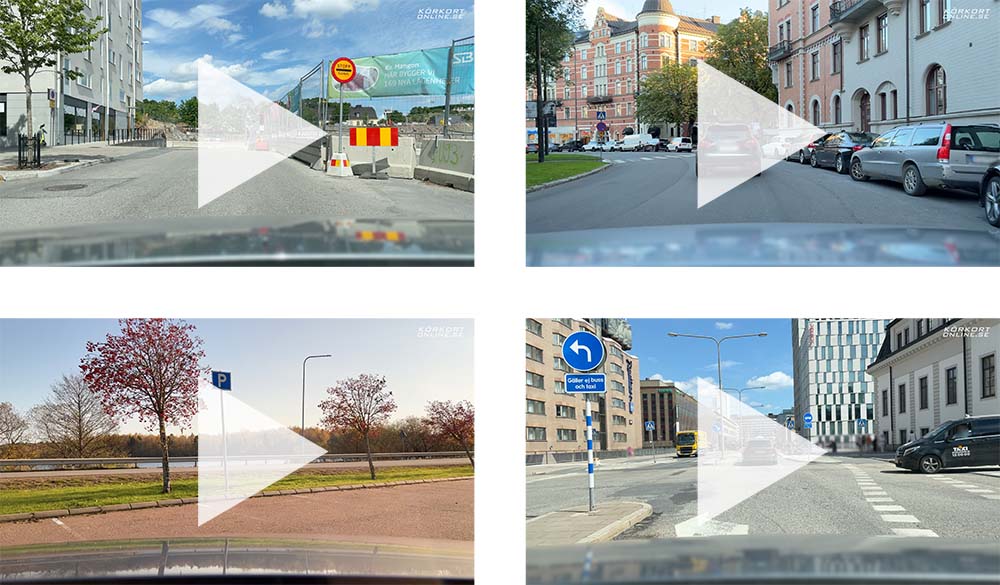Driving licence theory – Swedish driving licence book
Fundamental traffic rules
- Show consideration and care.
- Be considerate of those using the road and those who live near it.
- Be especially considerate of children, school traffic wardens, people with disabilities and the elderly.
- Do not cause any unnecessary disturbance or obstruction.
- No-one has any rights, only joint obligations.
Road, carriageway, lane and hard shoulder

- The road is everything (carriageway, lane and hard shoulder) put together.
- The carriageway is both lanes combined.
- The lane is where the cars are driving. The road will normally have two lanes going in opposite directions.
- The hard shoulder is the area outside the carriageway.
- This is a safety zone that shall primarily be used by pedestrians, cyclists, moped drivers and slow-moving vehicles.
- You may drive briefly on the hard shoulder in order, for example, to facilitate an overtaking. However, be very careful if you have limited visibility.
- Vehicles on the hard shoulder have an obligation to give way to vehicles on the carriageway.
Basic safety
- Clearly show your intentions.
- Make eye contact with the people who, for example, are using a pedestrian crossing or other drivers crossing your path.
- Always keep a safe distance. There is always the possibility of someone suddenly opening a car door or of a cyclist swerving.
You need to maintain a wide margin of safety when passing the cyclist. The cyclist will probably veer towards the centre of the road due to the parked car.
Defensive driving
Driving defensively makes for safer traffic. Examples of how to drive defensively:
- Do not take any unnecessary risks.
- Be sure to maintain wide safety margins.
- Stay vigilant.
- Do not stress, make sure you have plenty of time.
- Be prepared for unexpected things to happen.
- Analyse the situation before doing anything else.
- Think ahead and imagine what could happen.
- Drive smoothly and brake in good time.
Precedence
Sometimes you receive several messages simultaneously. You must then decide which to observe first. This is the order you should follow:
- Police signals (including a traffic director and similar).
- Traffic signals.
- Road signs.
- Rules (the priority-to-the-right rule, etc.).
You are not supposed to stop. The green traffic signal takes precedence over the stop sign.
Speed
- Adapt your speed, which means you must:
- Be in control of the vehicle.
- Be able to stop in the event of foreseeable obstacles.
- Take other traffic into consideration.
- Take the vehicle’s condition and load into consideration.
- Take the weather and road conditions into consideration.
- You may not brake suddenly or drive excessively slowly for no reason.
- The speed signs always take priority. However, there are a few basic speed limits, which may be of help if there are no signs:
- Built-up area: 50 km/h.
- Outside of built-up area: 70 km/h.

The speed limit is 70 km/h. However, driving at 70 km/h here is not appropriate as you are approaching a bend with limited visibility. The road is also icy.
Ambiguous traffic rules

Is the pedestrian waiting for the car to pass by? Or is he just about to cross the road?
Some rules are very clear, for example that you are not permitted to stop or park within 10 metres of a pedestrian crossing. It is simply a matter of judging the distance.
However, there are more ambiguous rules, such as you having an obligation to give way to pedestrians who “are about to step on to the pedestrian crossing”. What does “about to” mean? There is no exact answer; instead, the following process is used to discern whether or not you have adhered to the rule:
- You are reported for not giving way to a pedestrian.
- A court looks at the rules and relates them to your specific case.
- The court then decides whether you have violated those rules.
When it comes to ambiguous rules, you must therefore make a reasonable assessment and hope that your conclusion is shared by the judicial system.
Latest forum posts
- Introduction & terms ↑↑
- Lanes & placement >>



